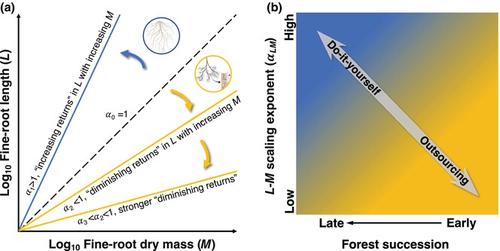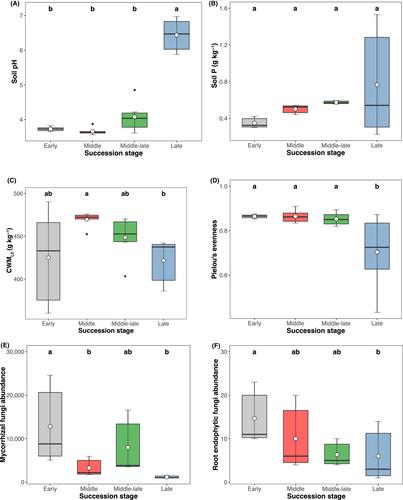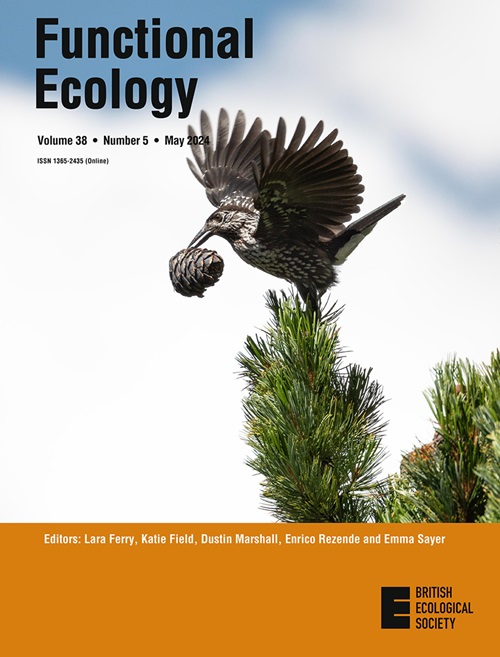土壤真菌导致细根长度与质量异构的 "收益递减 "效应增强,使热带雨林的演替更早
IF 5.1
1区 环境科学与生态学
Q1 ECOLOGY
引用次数: 0
摘要
随着叶片质量投入的增加,资源获取能力的收益会逐渐降低,这就是所谓的 "收益递减",它为植物经济提供了重要的启示。然而,细根是否也存在这种情况,以及根系获取资源的策略如何随着森林演替而变化,目前仍不清楚。我们研究了中国西南部西双版纳热带雨林四个演替阶段 24 个地块 215 个表土核心的细根长度(L)和质量(M)之间的比例关系。我们还利用层次变异分配法评估了土壤条件、叶片功能特征、树种多样性和土壤真菌因素对长度与质量比例关系的相对影响。我们的研究结果表明,根系长度的收益递减(L vs. M比例指数<1)在晚演替森林中高于早演替森林,这与晚演替阶段的 "自己动手 "策略转变为早演替阶段土壤真菌的 "外包 "资源吸收策略相对应。土壤真菌丰度是各地块L与M比例指数变化的主要驱动因素(解释了58%的变异),其中根内生真菌是最强的预测因子(22.11%),其次是菌根真菌(10.41%),而其他因子(叶片功能特征、土壤养分条件和树种多样性)的影响较弱。我们的研究结果表明,根内生真菌和菌根真菌是森林演替过程中根系经济变化的关键调节因子,但前者以前较少受到关注。与常用的比根长度相比,L 与 M 的比例指数可能是根系资源获取策略变化的更好指标。在期刊博客上免费阅读本文的通俗摘要。本文章由计算机程序翻译,如有差异,请以英文原文为准。



Soil fungi lead to stronger ‘diminishing returns’ in fine-root length versus mass allometry towards earlier successional tropical forests
Read the free Plain Language Summary for this article on the Journal blog.
求助全文
通过发布文献求助,成功后即可免费获取论文全文。
去求助
来源期刊

Functional Ecology
环境科学-生态学
CiteScore
9.00
自引率
1.90%
发文量
243
审稿时长
4 months
期刊介绍:
Functional Ecology publishes high-impact papers that enable a mechanistic understanding of ecological pattern and process from the organismic to the ecosystem scale. Because of the multifaceted nature of this challenge, papers can be based on a wide range of approaches. Thus, manuscripts may vary from physiological, genetics, life-history, and behavioural perspectives for organismal studies to community and biogeochemical studies when the goal is to understand ecosystem and larger scale ecological phenomena. We believe that the diverse nature of our journal is a strength, not a weakness, and we are open-minded about the variety of data, research approaches and types of studies that we publish. Certain key areas will continue to be emphasized: studies that integrate genomics with ecology, studies that examine how key aspects of physiology (e.g., stress) impact the ecology of animals and plants, or vice versa, and how evolution shapes interactions among function and ecological traits. Ecology has increasingly moved towards the realization that organismal traits and activities are vital for understanding community dynamics and ecosystem processes, particularly in response to the rapid global changes occurring in earth’s environment, and Functional Ecology aims to publish such integrative papers.
 求助内容:
求助内容: 应助结果提醒方式:
应助结果提醒方式:


